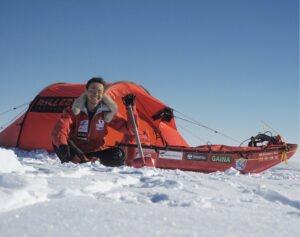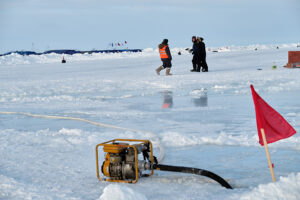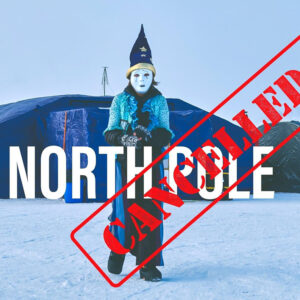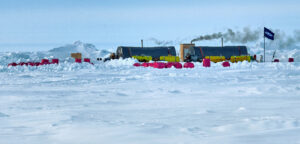Updates
(By Correne Coetzer) Frédérick Dion completed his 54-day, 3620 km traverse of Antarctica with a mammoth kite-ski push of 603 km in a straight line in 24 hours and 53 minutes on January 2, he reported today.
Newall Hunter reported on January 4 (Day 41) he has arrived at the Geographic South Pole at about 3.30 am (Union Glacier/ANI time).
Assisted Supported
(resupplied, wind-support)
Kite-ski Novo (November 10) – South Pole of Inaccessibility (December 14) – Geographic South Pole (December 24) – Hercules Inlet (January 2, 2015)
Frédéric Dion (CA)
The only other team who had kite-skied this route was the duo, Eric McNair-Landry and Sebastian Copeland. The men covered the Novo – POI – GSP – HI crossing in 80 days and arrived at Hercules Inlet on January 23, 2012. (Ed note: See AdventureStats.com]. They received an emergency resupply.
Fred also received an emergency resupply when his modified sled broke and he had to pick up another onefrom the Russian fuel depot at 83 degrees. At the Geographic South Pole, Fred enjoyed ANI’s delicious meals and received some fresh food. According to the Rules of Adventure, because he received supplies, Fred lost his solo status.
As for kiting on Antarctica, in 2008 Norwegian Ronny Finsaas kited from the South Pole to Hercules Inlet in 5 days and covered 502,73km in less than 24 hours; in a straight line between two camps.
In 2010 Eric and Sebastian set the 24-hour kite-ski distance record on a Greenland expedition when they covered 595 km in a straight line in 24 hours. Fred did not specify what distance he had covered in 24 hours.
The Canadian has already flown out of Antarctica via Union Glacier runway, and arrived in Punta Arenas, Chile.
Stats according to Fred’s website:
Day 51, Dec. 30
143 km
143 km
S 85 24.877′ W 080 45.768′
elev 1351 m
Day 52, Dec. 31
0 km
0 km
S 85 24.877′ W 080 45.768′
elev 1351 m
Day 53, Jan. 1
5 km
5 km
S 85 22.419′ W 080 41.278′
elev 1360 m
Day 54, Jan. 2
627 km
603 km [straight-line distance]
S 79 58.381′ W 079 45.337′
elev 300 m
Assisted Unsupported
(resupplied, no wind/vehicles)
Newall Hunter(UK, Messner to GSP)
Newall said when he stopped his goggles froze up. “Every time I stop for a break to eat or drink the goggles freeze and it takes couple of hours before they defrost, just in time for the next break.”
Nearing the Pole, “the weather was perfect and just cold enough to make skiing comfortable, Newall reported, and added, overheating is a real problem while skiing and pulling the pulks.
Because of Newall’s early morning arrival at the South Pole, everyone at ANI was asleep, at the South Pole Camp and Union Glacier. Fortunately a liaison lady from the US Station saw him out of a window and came out to help him take photographs. The Station uses New Zealand time because they fly to Antarctica from New Zealand. Union Glacier uses Chilean time because they fly in from Chile.
Newall made himself at home in the ANI dining tent with coke and cookies and luxuries like a chair and a hot stove.
The Brit received a resupply along the way and in the process also lost his solo status according to The Rules of Adventure. Although he has completed his ski mission, he is not finished yet as he is going to climb Mount Vinson.
Unassisted Supported
(no resupplies, wind-support)
Solo traverse Novo – Geographic SP – Hercules Inlet
Faysal Hanneche (FR)
Faysal is well aware that the weather is in control of his expedition and said he will adapt accordingly. On January 2 he reported the largest crevasses field he has ever seen. When he rounded that, he saw the largest sastrugi field he has ever seen. Faysal’s knees and sled took a knock in the harsh terrain.
Distances:
100 km in 11 hours (Jan.1)
125 km (Jan. 2)
Positions according to his map:
01/01/2015
82.2525, 011.1561
03/01/2015
83.3761, 010.7697
Assisted Unsupported
(resupplies, no wind/vehicles)
Traverse Messner – Geographic SP (December 23) – Hercules Inlet
Stéphanie Gicquel(FR)
Jérémie Gicquel (FR)
Are Johansen (NO)
After keeping “a reasonable pace” across the plateau to keep as much strength as possible for the way down, explained the French couple, the team has increased their pace. AJ reported their latest daily distances as 31.5 km, 33.6 km and 41 km on Day 52. They crossed the sastrugi fields again and the Norwegian described them as fantastic and as big as houses and buses. “Some nice shadows patching on them to make them look like cartoon-figures. Never boring.”
The trio increased their ski hours to 10 hours per day. They picked up a resupply with some treats on Day 52.
January 3, 2015 stats:
S 87° 44′ , W 082° 16′
Temp : -24°C (windchill: -37°C)
Adventure Consultants team
Hercules Inlet route
Einar Torfi Finnsson (IS, guide)
Hugh Dougall (CA)
William (Bill) Morrison (UK)
Tim Garrett (AU)
The Hercules Inlet team gained altitude towards the plateau and entered the sastrugi fields. On Dec. 3 Einar said the last two days were a bit hard because of the terrain. “This time [the sastrugi] are from southeast to northwest. This means we have to go across each and every one instead of skiing along them as we some times could before.”
Distances:
24.1 km, 26.2 km, 28 km, 22 km (January 3)
Camp 37 at 86°55’308 S 81°32’543 W
Camp 38 at 87°07’413 S 81°43’668 W
ANI Messner Route team
Robert Smith (guide)
Paula J Reid (UK)
Arabella Slinger (UK)
Julian Thomas (UK)
The team is out of the infamous sastrugi fields, took a detour around a crevasses area and encountered the sticky snow on the plateau, which makes for tough going, reported Paula’s home team.
Yesterday Julian reported they have 140 km ahead of them to the South Pole.
5th Jan 2015 @ 12:00:21 UTC
88° 59.22S, 081° 08.04W
2734m above sea level
PolarExplorers team
Messner route
Keith Heger (CA, guide)
Ian Evans (CA)
Andy Styles (UK)
Bradley Cross(UK)
According to the team’s latest report, they have only 24 nautical miles to the Pole. Judging by their pace, it should take them two days for arrival on January 6.
Follow daily team blogs with RSS feeds in the News Stream at Explorersweb






